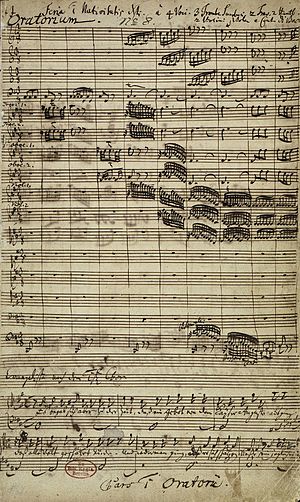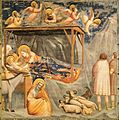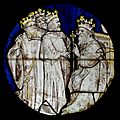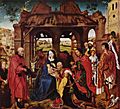Christmas Oratorio facts for kids
The Christmas Oratorio (which means Weihnachts-Oratorium in German) is a famous piece of music. It was written by a well-known composer named Johann Sebastian Bach. This special music tells the story of Jesus' birth. It uses parts from the Bible, specifically the gospels of Matthew and Luke.
Contents
A Musical Story for Christmas
Before writing the Christmas Oratorio, Bach had already created other musical pieces. These were called cantatas and were also for the Christmas season.
Bach wrote the Christmas Oratorio in 1734. It was created especially for the Christmas celebrations that year. The music was first performed in two churches in Leipzig, Germany. These were the Thomaskirche and the Nikolaikirche.
The Music of the Oratorio
The Christmas Oratorio is divided into six main parts. Each part is meant to be performed on a specific day during the Christmas season. Some of the music in the oratorio was even taken from other works Bach had composed earlier.
Chorales: Songs for Everyone
In his church music, Bach often used special melodies called chorales. These were German church hymns. They were well-known tunes that people could sing along to.
The Six Parts
Each part of the oratorio tells a different part of the Christmas story. They also use different musical instruments.
Part I: The Birth of Jesus
Part I is performed on Christmas Day (December 25). The music and words tell the story of Jesus' birth.
The instruments for this part include:
- 3 trumpets
- timpani (drums)
- 2 flutes
- 2 oboes (players also use oboe d'amore)
- 2 violins
- viola
- And the basso continuo (a group of instruments that play the bass line and chords)
Part II: The Shepherds
Part II is performed on the second day of Christmas (December 26). This part focuses on the shepherds.
The instruments for this part include:
- 2 flutes
- 2 oboes d'amore
- 2 oboes da caccia
- 2 violins
- viola
- And the basso continuo
Part III: The Shepherds Worship
Part III is performed on the third day of Christmas (December 27). This section continues the story of the shepherds.
The instruments used in Part III are the same as those in Part I.
Part IV: New Year's Day
Part IV is performed on New Year's Day (January 1). This part often tells about the naming of Jesus.
The instruments for this part include:
- 2 horns
- 2 oboes
- 2 violins
- viola
- And the basso continuo
Part V: The Journey of the Magi
Part V is performed on the Sunday after New Year's Day. This section tells about the Magi (wise men) and their journey.
The instruments for this part include:
- 2 oboes d'amore
- 2 violins
- viola
- And the basso continuo
Part VI: The Adoration of the Magi
Part VI is performed on the holiday of Epiphany. This day celebrates the wise men visiting Jesus.
The instruments used in Part VI are the same as those in Part I.
Images for kids
-
Georges de La Tour: Adoration of the Shepherds (1644)
-
Giotto: Angels at the Nativity (c. 1300)
-
Rogier van der Weyden: Adoration of the Magi (c. 1430–60)
See also
 In Spanish: Oratorio de Navidad para niños
In Spanish: Oratorio de Navidad para niños











